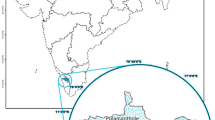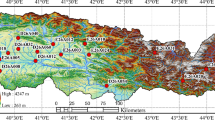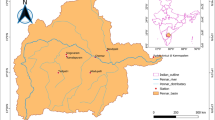Abstract
There are two kinds of uncertainty factors in modeling the bivariate distribution of hydrological droughts: the alteration of predefined critical ratios for pooling droughts and excluding minor droughts and the temporal variability of univariate and/or bivariate characteristics of droughts due to the impact of human activities. Daily flow data covering a period of 56 hydrological years from two gauging stations from a humid region in South China are used. The influences of alterations of threshold values of flow and critical ratios of pooling droughts and excluding minor droughts on drought properties are analyzed. Six conventional univariate models and three Archimedean copulas are employed to fit the marginal and joint distributions of drought properties, the Kolmogorov–Smirnov and Anderson–Darling methods are used for testing the goodness-of-fit of the univariate model, and the Cramer-von Mises method based on Rosenblatt’s transform is applied for the test of the bivariate model. The change point analysis of the copula parameter of bivariate distribution of droughts is first made. Results demonstrate that both the statistical characteristics of each drought property and their bivariate joint distributions are sensitive to the critical ratio of excluding minor droughts. A model can be selected to fit the marginal distribution for drought deficit volume or maximum deficit, but it is not determined for drought duration with the lower ratios of the pooling and excluding droughts. The statistical uncertainty of drought duration makes the modeling of bivariate joint distribution of drought duration and deficit volume or of drought duration and maximum deficit undermined. Change points significantly occurred in the period from the late 1970s to the middle 1980s for a single drought property and the copula parameter of their joint distribution due to the impact of human activities. The difference between two subseries separated by the change point is remarkable in the magnitudes of drought properties and the joint return periods. A copula function can be selected to optimally fit the bivariate distribution, provided that the critical ratios of pooling and excluding droughts are great enough such as the optimal value of 0.4 in the case study. It is valuable that the modeling and designing of the bivariate joint correlation and distribution of drought properties can be performed on the subseries separated by the change point of the copula parameter.









Similar content being viewed by others
References
Abdul Rauf UF, Zeephongsekul P (2014) Copula based analysis of rainfall severity and duration: a case study. Theor Appl Climatol 115:153–166
Burn DH, Wychreschuk J, Bonin DV (2004) An integrated approach to the estimation of stream flow drought quantiles. Hydrol Sci J 49(6):1011–1024
Byzedi M (2010) Analysis of hydrological drought based on daily flow series. Proc World Acad Sci Eng Technol 70:249–252
Cancelliere A, Salas JD (2004) Drought length properties for periodic-stochastic hydrological data. Water Resour Res 40(2):W02503. doi:10.1029/2002WR001750
Chebana F, Ouarda TBMJ (2011) Depth-based multivariate descriptive statistics with hydrological applications. J Geophys Res 116:D10120. doi:10.1029/2010JD015338
Chen YD, Zhang Q, Xiao M, Singh VP (2013) Evaluation of risk of hydrological droughts by the trivariate Plackett copula in the East River basin (China). Nat Hazards 68(2):529–547
Chung CH, Salas JD (2000) Drought occurrences probabilities and risks of dependent hydrologic processes. J Hydrol Eng 5(3):259–268
De Michele C, Salvadori G, Vezzoli R, Pecora S (2013) Multivariate assessment of droughts: frequency analysis and dynamic return period. Water Resour Res 49(10):6985–6994
Dobric J, Schmid F (2007) A goodness of fit test for copulas based on Rosenblatt’s transformation. Compu Stat Data An 51(9):4633–4642
Dracup J, Lee K, Paulson EJ (1980) On the definition of droughts. Water Resour Res 16(2):297–302
Durante F, Salvadori G (2010) On the construction of multivariate extreme value models via copulas. Environmetrics 21(2):143–161
Fernandez B, Salas JD (1999) Return period and risk of hydrologic events I: mathematical formulation. J Hydrol Eng 4(4):297–307
Fleig AK, Tallaksen LM, Hisdal H, Demuth S (2006) A global evaluation of streamflow drought characteristics. Hydrol Earth Syst Sci 10:535–552
Ganguli P, Reddy MJ (2012) Risk assessment of droughts in Gujarat using bivariate copulas. Water Resour Manage 26(11):3301–3327
Ganguli P, Reddy MJ (2014) Evaluation of trends and multivariate frequency analysis of droughts in three meteorological subdivisions of western India. Int J Climatol 34(3):911–928
Genest C, Favre AC (2007) Everything you always wanted to know about copula modeling but were afraid to ask. J Hydrol Eng 12(4):347–368
Genest C, Rivest LP (1993) Statistical inference procedures for bivariate Archimedean copulas. J Am Stat Assoc 88(423):1034–1043
Genest C, Remillard B, Beaudoin D (2009) Goodness-of-fit tests for copulas: a review and a power study. Insur Math Econ 44(2):199–213
Graler B, Van Den Berg MJ, Vandenberghe S, Petroselli A, Grimaldi S, De Baets B, Verhoest NEC (2013) Multivariate return periods in hydrology: a critical and practical review focusing on synthetic design hydrograph. Hydrol Earth Syst Sci 17:1281–1296
Gringorten II (1963) A plotting rule for extreme probability paper. J Geophys Res 68(3):813–814
Hong XJ, Guo SL, Zhou YL, Xiong LH (2015) Uncertainties in assessing hydrological drought using streamflow drought index for the upper Yangtze River basin. Stoch Environ Res Risk Assess 29(4):1235–1247
Jiang C, Xiong LH, Xu CY, Guo SL (2015) Bivariate frequency analysis of nonstationary low-flow series based on the time-varying copula. Hydrol Process 29(6):1521–1534
Kao SC, Govindaraju RS (2010) A copula-based joint deficit index for droughts. J Hydrol 380(1–2):121–134
Khedun CP, Mishra AK, Singh VP, Giardino JR (2014) A copula-based precipitation forecasting model: investigating the interdecadal modulation of ENSO’s impacts on monthly precipitation. Water Resour Res 50(1):580–600
Kroll CN, Vogel RM (2002) Probability distribution of low streamflow series in the United States. J Hydrol Eng 7(2):137–146
Kuchment LS, Demidov VN (2013) Probabilistic characterization of hydrological droughts. Russ Meteorol Hydrol 38(10):694–700
Lavielle M, Teyssiere G (2006) Detection of multiple change-points in multivariate time series. Lith Math J 46(3):287–306
Lee T, Salas JD (2011) Copula-based stochastic simulation of hydrological data applied to Nile River flows. Hydrol Res 42(4):318–330
Lee T, Modarres R, Ouarda TBMJ (2013) Data-based analysis of bivariate copula tail dependence for drought duration and severity. Hydrol Process 27(10):1454–1463
Liu DD, Chen XH, Lian YQ, Lou ZH (2010) Impacts of climate change and human activities on surface runoff in the Dongjiang River Basin of China. Hydrol Process 24(21):1487–1495
Ma MW, Song SB, Ren LL, Jiang SH, Song JL (2013) Multivariate drought characteristics using trivariate Gaussian and Student t copulas. Hydrol Process 27(8):1175–1190
Madsen H, Rosbjerg D (1995) On the modelling of extreme droughts. In: Modelling and management of sustainable basin-scale water resource systems (Proceedings of a boulder Symposium). IAHS Publ NO. 231
Milly PCD, Betancourt J, Falkenmark M, Hirsch RM, Kundzewicz ZW, Lettenmaier DP, Stouffer RJ (2008) Stationarity is dead: whither water management? Science 319:573–574
Mishra AK, Singh VP (2010) A review of drought concepts. J Hydrol 391(1–2):202–216
Mishra AK, Singh VP (2011) Drought modeling—a review. J Hydrol 403(1–2):157–175
Modarres R, Sarhadi A (2010) Frequency distribution of extreme hydrologic drought of southeastern semiarid region. Iran. J Hydrol Eng 15(4):255–264
Nadarajah S (2009a) A bivariate distribution with gamma and beta marginals with application to drought data. J Appl Stat 36(3):277–301
Nadarajah S (2009b) A bivariate pareto model for drought. Stoch Environ Res Risk A 23(6):811–822
Nelsen RB (2006) An introduction to copulas. Springer, New York
Panchenko V (2005) Goodness-of-fit test for copulas. Phys A 355(1):176–182
Pettitt AN (1979) A non-parametric approach to the change-point problem. J Appl Stat 28:126–135
Pettitt AN (1980) A simple cumulative sum type statistic for the change-point problem with zero-one observations. Bio-metrika 67(1):79–84
Poulin A, Huard D, Favre AC, Pugin S (2007) Importance of tail dependence in bivariate frequency analysis. J Hydrol Eng 12(4):394–403
Reddy MJ, Ganguli P (2012) Application of copulas for derivation of drought severity-duration-frequency curves. Hydrol Process 26(11):1672–1685
Rosenblatt M (1952) Remarks on a multivariate transformation. Ann Math Statist 23(3):470–472
Ryu JH, Lee JH, Jeong S, Park SK, Han K (2011) The impacts of climate change on local hydrology and low flow frequency in the Geum River Basin. Korea. Hydrol Process 25(22):3437–3447
Salvadori G, De Michele C (2004) Frequency analysis via copulas: theoretical aspects and applications to hydrological events. Water Resour Res 40(12):W12511. doi:10.1029/2004WR003133
Salvadori G, De Michele C (2010) Multivariate multiparameter extreme value models and return periods: a copula approach. Water Resour Res 46(10):W10501. doi:10.1029/2009WR009040
Salvadori G, De Michele C, Durante F (2011) On the return period and design in a multivariate framework. Hydrol Earth Syst Sci 15:3293–3305
Salvadori G, Durante F, De Michele C (2013) Multivariate return period calculation via survival functions. Water Resour Res 49(4):2308–2311
Serinaldi F, Bonaccorso B, Cancelliere A, Grimaldi S (2009) Probabilistic characterization of drought properties through copulas. Phys Chem Earth 34(10–12):596–605
Shiau JT (2006) Fitting drought duration and severity with two dimensional copulas. Water Resour Manag 20(5):795–815
Shiau JT, Modarres R (2009) Copula-based drought severity-duration-frequency analysis in Iran. Meteorol Appl 16(4):481–489
Shiau JT, Feng S, Nadarajah S (2007) Assessment of hydrological droughts for the Yellow River China, using copulas. Hydrol Process 21(16):2157–2163
Singh VP, Zhang L (2007) IDF curves using the Frank Archimedean copula. J Hydrol Eng 12(6):651–662
Sklar A (1959) Fonctions de repartition an dimensions et leurs marges. Publ Inst Stat Univ Paris, pp 229–231
Smakhtin VY (2001) Low flow hydrology: a review. J Hydrol 240(3–4):147–186
Song SB, Singh VP (2010a) Meta-elliptical copulas for drought frequency analysis of periodic hydraulic data. Stoch Env Res Risk A 24(3):425–444
Song SB, Singh VP (2010b) Frequency analysis of droughts using the Plackett copula and parameter estimation by genetic algorithm. Stoch Env Res Risk A 24(5):783–805
Tallaksen LM, Madsen H, Clausen B (1997) On the definition and modelling of streamflow drought duration and deficit volume. Hydrol Sci J 42(1):15–33
Tu XJ, Zhang Q, Singh VP, Chen XH, Liu CL, Wang SB (2012) Space-time changes in hydrological processes in response to human activities and climatic change in the south China. Stoch Env Res Risk A 26(6):823–834
Tu XJ, Singh VP, Chen XH, Ma MW, Zhang Q, Zhao Y (2015) Intra-annual distribution of dtreamflow and individual impacts of climate change and human activities in the Dongijang River basin. China. Water Resour Manage 29(8):2677–2695
Van Loon AF, Van Lanen HAJ (2013) Making the distinction between water scarcity and drought using an observation-modeling framework. Water Resour Res 49(3):1483–1502
Van Loon AF, Tijdeman E, Wanders N, Van Lanen HAJ, Teuling AJ, Uijlenhoet R (2014) How climate seasonality modifies drought duration and deficit. J Geophys Res Atmos 119(8):4640–4656
Wong G, Lambert MF, Leonard M, Metcalfe AV (2010) Drought analysis using trivariate copulas conditional on climate states. J Hydrol Eng 15(2):129–141
Yevjevich V (1967) An objective approach to definitions and investigations of continental hydrologic droughts. Hydrol Pap 23, Colorado State University, Fort Collins, Colorado
Zaidman MD, Keller V, Young AR, Cadman D (2003) Flow-duration-frequency behaviour of British rivers based on annual minima data. J Hydrol 277(3–4):195–213
Zelenhasic E, Salvai A (1987) A method of streamflow drought analysis. Water Resour Res 23(1):156–168
Zhang L, Singh VP (2007a) Bivariate rainfall frequency distributions using Archimedean copulas. J Hydrol 332(1–2):93–109
Zhang L, Singh VP (2007b) Gumbel-Hougaard copula for trivariate rainfall frequency analysis. J Hydrol Eng 12(4):409–419
Zhang L, Singh VP (2007c) Trivariate flood frequency analysis using the Gumbel–Hougaard copula. J Hydrol Eng 12(4):431–439
Zhang Q, Chen YD, Chen X, Li J (2011) Copula-based analysis of hydrological extremes and implications of hydrological behaviors in the Pearl River basin. China. J Hydrol Eng 16(7):598–607
Zhang Q, Li JF, Singh VP, Xu CY (2013) Copula-based spatio-temporal patterns of precipitation extremes in China. Int J Climatol 33:1140–1152
Zhang Q, Singh VP, Li K, Li JF (2014) Trend, periodicity and abrupt change in streamflow of the East River, the Pearl River basin. Hydrol Process 28(2):305–314
Acknowledgments
Supported by the National Natural Science Foundation of China (Grant NO: 51479217, 51479216), the Open Research Fund of State Key Laboratory of Simulation and Regulation of Water Cycle in River Basin (China Institute of Water Resources and Hydropower Research, Grant NO: IWHR-SKL-201314), and the State Scholarship Fund of the China Scholarship Council (Grant No: 201308440054) are gratefully acknowledged.
Author information
Authors and Affiliations
Corresponding author
Rights and permissions
About this article
Cite this article
Tu, X., Singh, V.P., Chen, X. et al. Uncertainty and variability in bivariate modeling of hydrological droughts. Stoch Environ Res Risk Assess 30, 1317–1334 (2016). https://doi.org/10.1007/s00477-015-1185-3
Published:
Issue Date:
DOI: https://doi.org/10.1007/s00477-015-1185-3




